Bob Cofer
Guru
Our old GB had the chain driven AP in the lower helm along with cable steering, one of our other boats had a hydraulic AP system along with hydraulic steering.
Our cruising grounds are Puget Sound to northern Canada. Having an AP is in no way a deal breaker and I would say that it makes you less attentive to your surroundings. Our current boat does not have an AP and I don't miss it at all. Watching your surroundings while at the helm adds to the enjoyement of cruising around here.
Our cruising grounds are Puget Sound to northern Canada. Having an AP is in no way a deal breaker and I would say that it makes you less attentive to your surroundings. Our current boat does not have an AP and I don't miss it at all. Watching your surroundings while at the helm adds to the enjoyement of cruising around here.


